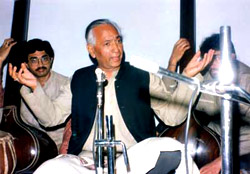 By common consent, the Gwalior gharana is regarded as the mother of all gharanas as it is the oldest, the largest, and one of the most enduring. A number of singing styles prevalent today are traceable to this tradition. It is not until the first half of the 19th century that one can find mention of it in records. The founders of this gharana were Natthan and Khadir Pir Baksh. Natthan Pir Baksh moved to the Gwalior court of Maharaja Jhinkuji Rao Scindhia from Lucknow along with his grandsons, Haddu Khan and Hassu Khan. The latter duo were chiefly instrumental in evolving the Gwalior style from the existing Qawwal-Bacche tradition of Bade Mohammed Khan. Incidentally, it was Bade Mohammed Khan who styled and popularised the khayal mode of singing, as one knows today. He was the one who had introduced the distinguishing stylisations so typical of khayal gayaki, like the use of aakaar (using a while developing the song-text), as also complex and intricate taan patterns. Hassu and Haddu Khan adopted and adapted these features to create the Gwalior gayaki.
By common consent, the Gwalior gharana is regarded as the mother of all gharanas as it is the oldest, the largest, and one of the most enduring. A number of singing styles prevalent today are traceable to this tradition. It is not until the first half of the 19th century that one can find mention of it in records. The founders of this gharana were Natthan and Khadir Pir Baksh. Natthan Pir Baksh moved to the Gwalior court of Maharaja Jhinkuji Rao Scindhia from Lucknow along with his grandsons, Haddu Khan and Hassu Khan. The latter duo were chiefly instrumental in evolving the Gwalior style from the existing Qawwal-Bacche tradition of Bade Mohammed Khan. Incidentally, it was Bade Mohammed Khan who styled and popularised the khayal mode of singing, as one knows today. He was the one who had introduced the distinguishing stylisations so typical of khayal gayaki, like the use of aakaar (using a while developing the song-text), as also complex and intricate taan patterns. Hassu and Haddu Khan adopted and adapted these features to create the Gwalior gayaki.
Haddu Khan had two sons - Mohammed Khan and Rehmat Khan. Both of them left their impressions in the field, especially the latter as one can understand later. Until this point, training in music was permeated with clannishness and parochialism. Haddu Khan`s liberal move to open the doors of music to non-family members was to bring about the great musical revolution in Maharashtra during the first half of the 20th century. The most famous of his Hindu disciples was Balakrishnabua Icchalkaranjikar who was responsible for popularising Gwalior gayaki among the public in Maharashtra and perpetuating it through a galaxy of stupendously luminous disciples like Vishnu Digambar Paluskar, Anant Manohar Joshi, Mirsashibua and Nilakanthbua Alurmath. The constellation of great names associated with this gharana during the latter part of the 19th and the first half of the 20th century are Nissar Hussain Khan (1844-1916), Krishnarao Shankar Pandit (1893-1989), Rajabhaiya Poochwale (1882-1956), Ramakrishnabua Vaze (1871-1945), Narayanrao Vyas (1902-1984), Vinayakrao Patwardhan (1898-1975), Pt. Omkarnath Thakur (1897-1967), B.R. Deodhar (1901-1990) and D.V. Paluskar (1921-1955). Among the post-Independence generation of singers, Malini Rajurkar and Veena Sahasrabuddhe, and Ulhas Kashalkar, while largely grounded in the Gwalior gayaki, have not hesitated to imbibe much from other traditions and idioms. Yeshwantbua Joshi, Vinaychandra Maudgalya, Sharatchandra Arolkar, L.K. Pandit and Vidhyadhar Vyas have, for the most part, remained the unfaltering purists of this gayaki.
Some of the distinguishing features of the gharana are
• The rendition of the sthayi and antara of the bandish, or the song-text one after another, correctly and methodically. This is only to imprint the idea of the raaga fully in the listener`s mind by contrasting the mood of the former with the latter. The elaboration of the raaga is referred to by the Gwalior singers as sthayi-bharna or `filling the sthayi`. Gravity, simplicity and sobriety, characterize their approach to ragas (at least that of the purists).
• Use of aakaar or the vowel sound a for raaga alaap.
• Emphasis laid on the bandish and its proper development. In fact, given their rich repertoire of bandishes, they believe that many facets in aesthetically pleasing ways.
• Use of behelvas or singing of the notes of the raaga in aakaar, after singing the antara, beginning with the lower octave and concluding with the pleasing ways.
• Preference for the medium tempo or the madhya laya.
• Use of simple and straight taans.
• Command over uncommon musical forms like khayalnuma, dadra, chaturang, tappa and tapkhayal.




